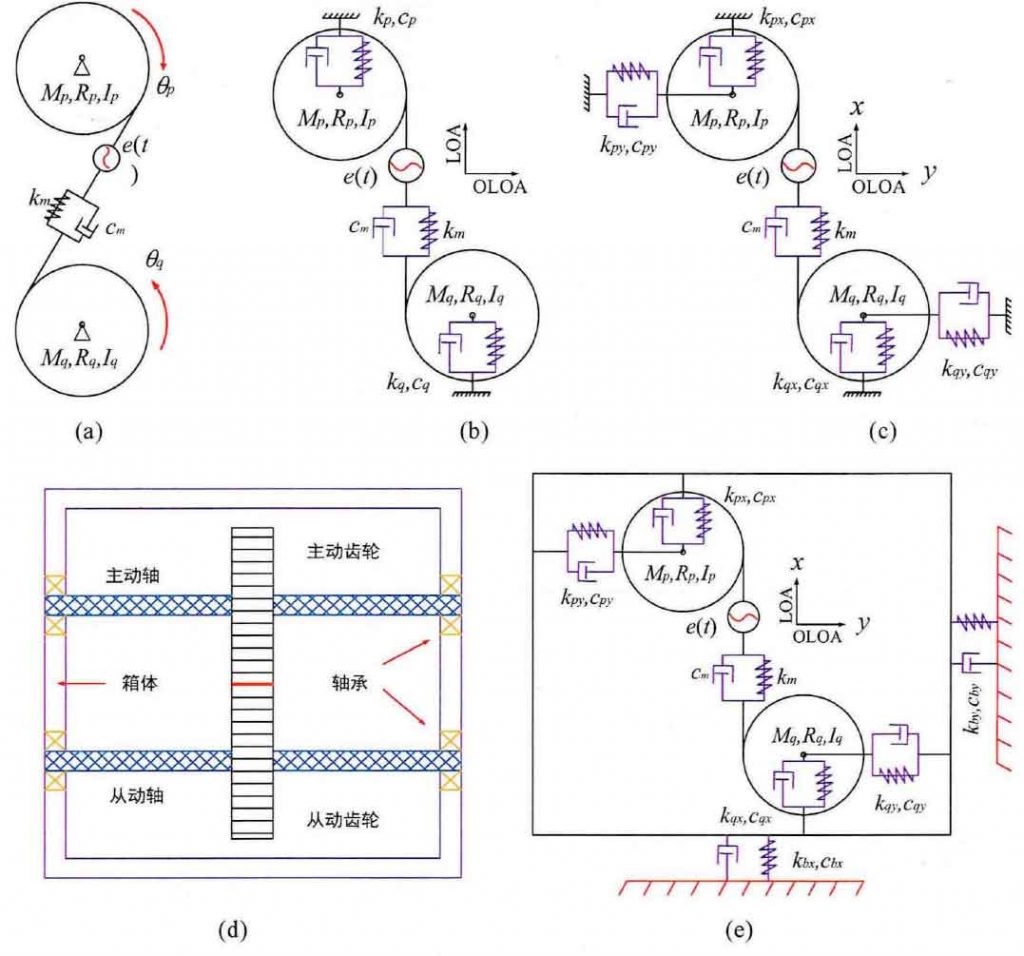Figure (b) and (c) the torsional vibration dynamic model of elastic support model (figure) (a) effect can reflect more parameters, the multielement analysis ideas and methods, such as the meshing force, friction force and bearing force, etc., not only can analyze the gear pair meshing state analysis, also can analyze the elastic supporting element real-time response, at the same time achieve tooth surface geometry characteristics, the microstructure characteristics, elastic support stiffness coupling and coordination optimization parameters such as response effect. If the package box of gear group also needs to be further considered as an elastomer or an elastic support between the box and the earth, the mathematical analysis model of system dynamics of the elastic support of the box as shown in Figure (d) and Figure (e) can be further improved.
Ren Yafeng and Liu Lan build system such as the coupling dynamic model of the base of analysis of flexible body, elastic support on the system natural frequency and bearing reaction force, and so on the influence of the dynamic characteristics of gear meshing force, the results show that the flexible body gear meshing force for bearing reaction force effect obviously, and the vibration of the rotating speed of the system has certain random distribution, reveals the full coupling model can more accurately reflect the dynamic characteristics of system.
The dynamics mathematical model listed in the figure mainly adopts the centralized mass method modeling method, which has the characteristics of fast modeling speed, fast analysis speed and high timeliness. It is the mainstream analysis modeling and research method for dynamics simulation analysis at present, and it can quickly control and predict the vibration response of the system. In addition, the modeling methods listed in the figure include transfer matrix method, finite element method, dynamic substructure modal method and so on. In these three methods, the system components are considered as elastomers or rigid-elastic coupling bodies to establish the mathematical constitutive equations of the ontology for analysis. Therefore, the computational mathematical equations of the ontology are huge, which is not conducive to the solution and the output of the results. However, the application of the elastomer structure makes the results more authentic and close to the test results. In particular, the finite element method discretized the elastomer into numerous small elastomers, which could output the response of any surface point of the gear system as much as possible, and the response output results could monitor the vibration or noise of any point’s unsteady response characteristics, etc.
Ren Yafeng et al. established the finite element discrete analysis model of the flexible box, studied the displacement response of the bearing bearing position of the box by using the substructure analysis method, and combined with the dynamic model of the concentrated mass method, studied the contribution of the flexible box to the system meshing force, bearing force and the unsteady response of vibration and noise. Cappellini et al. established a discrete finite element analysis model for single-pair gear engagement, and calculated the angular displacement, transmission error, dynamic transmission error and other response changes under PMOR Standard (non-Hertz contact) and PMOR Hertz (Hertz contact) forms.

